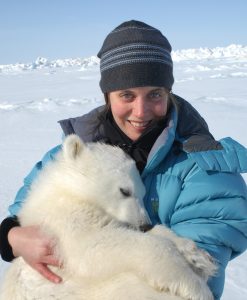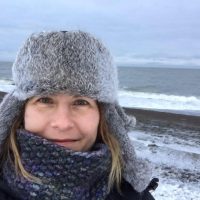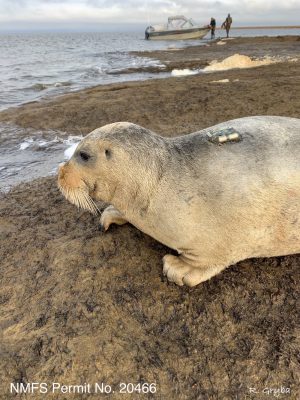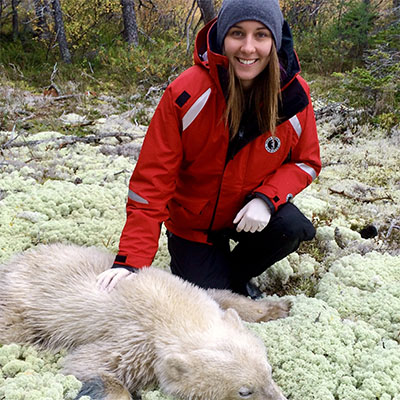Most ecological questions can’t be answered with experiments. This is because changing an ecosystem to see how the interactions between organisms within that ecosystem shifts is impractical, costly and, in most cases, ethically questionable.
Thus, the ecologist’s toolkit often relies heavily on observation and collection of data. However, making sense of this data can be daunting, especially as technology improves and our picture of the animal world becomes both more focused and more complex.
Wrestling with pesky ecological data is the Statistical Ecology Research Group’s (SERG) specialty.

Dr. Marie Auger-Méthé
Auger-Méthé is interested in animal movement. Many of the animals Auger-Méthé and her students investigate travel vast distances across remote sea ice sheets, or dive deep underwater, or swim through Arctic currents to find food, mates and shelter. Following them is often impractical and, in some cases, dangerous.
To bypass this hurdle, researchers use GPS-like trackers that can be attached to an animal to collect information on its whereabouts. However, the investigation doesn’t stop once information comes back from a tag.
“This issue with animal movement data is that it has a lot of complexity, especially in the marine world because GPS tags don’t work underwater,” Auger-Méthé said. “When you track marine animals for example, there is lots of measurement error. You get a location, but that can be quite far from where the animal actually is. Part of what my group does is develop tools to handle that noise and take that super messy data to say ‘no, actually, the turtle, or narwhal, or seal is not there, it’s over here.’”
Understanding where an animal spends its time is only half the battle. To truly improve conservation efforts, researchers must also learn what animals do in their habitats.
The SERG designs statistical methods that can untangle whether a whale is seeking food when it dives in a certain pattern, whether polar bears are searching for prey or migrating, and why seals spend time in one part of the ocean vs. another.
These methods often apply to more species than the ones that are of interest to SERG researchers.
“People need to develop these methods for ecologists to apply them,” Auger-Méthé said.
“Most ecologists aren’t statisticians — they just want a statistical method that works for their data. That’s where people like us come in.”
Quantifying Indigenous Knowledge

Rowenna Gryba
Rowenna Gryba, a PhD student at the SERG, was finding and tagging seals in the Arctic sea when a conversation with an Indigenous hunter changed her research approach entirely and led to her PhD.
“I had done an analysis to estimate or predict where seals were feeding and travelling,” Gryba said. “After I’d done all of this work, I presented those results to some of the hunters and researchers, and one of the hunters I know said, ‘Oh yeah, that make sense.’ And of course he knew where the seals were and what they were doing. He’s hunted the species since childhood; his parents and grandparents had hunted them and had generations of knowledge. Here I am with five tagged seals going, ‘Look! I know where they’re eating!’”

Ringed seal, the smallest and most common seal in the Arctic. Photo: R. Gryba.
Indigenous Knowledge is being used more frequently to complement environmental studies, but this is a rare case in which the information that Indigenous knowledge-holders share with Gryba will make its way into statistical models predicting animal movement and habitat use.
Gryba has been interviewing hunters to learn where they spot seals, what behaviours the seals are engaged in, and what habitat the seals prefer. These interviews get transformed into visuals like graphs and charts that Gryba takes back to the hunters for a second look.
She has already discovered unexpected patterns of behaviour, such as bearded seals moving further out to sea when they smell wind moving across land and ringed seals foraging in rivers.
“I could never do this work if I didn’t work with hunters who were willing to share their information,” Gryba said. “I’m just privileged to be able to do this.”

A bearded seal with a tracker on its back. Photo. R. Gryba.
Statistics and seals
Gryba isn’t the only SERG student investigating seals.
When Katie Florko joined the SERG as a PhD student, she planned to use seal and polar bear tracking data to test the “landscape of fear” hypothesis, which predicts that a predator’s use of space affects the movements and behaviour of its prey.
“One reason seals are so cool is that they’re balancing finding food and not becoming food,” Florko said. “I was interested in teasing apart these two pressures.”
However, when Florko proposed her study, she encountered a problem: no one knew exactly where and in what quantity prey were available for ringed seals throughout Hudson Bay.
She teamed up with researchers from the Changing Ocean Research Unit to build a model of the prey base for Hudson Bay ringed seals and see how the abundance for those prey species had been changing over time. They discovered a shift in the food web, with the fatty Arctic cod that seals like to eat declining and being replaced in some areas by smaller, skinnier fish.
Now Florko is using the food web model along with seal movement data to see how the seals interact with their prey.

Katie Florko
“We’ve started to think about the nuances of results from these types of models — maybe it looks like they’re foraging less in areas with high prey density, but they’re just more efficient when there’s a lot of prey and not very efficient when there’s little”.
The final step of Florko’s project will be to create a “predator/prey” model using seals and bears as a case study. It will reveal how the movements of predators affect the movement of their prey and vice versa.
The point of doing all of this work, according to Florko, is to understand where seals are doing important behaviours, such as foraging, in hope of finding ways to curb damaging, human-caused impacts to their habitats.
It’s a goal that Auger-Méthé shares.
“Identifying critical habitat is a complex question that requires understanding the movement of the animal, where they spend time and what they do in these places,” Auger-Méthé said. “That is principally what we do at the SERG. Even though our work seems complex and abstract, the end result of our work is very tangible.”
By Riley Tjosvold
Tags: animal movement, faculty, IOF students, Marie Auger-Methe, observation, polar bears, Research, satellite data, seals, SERG, tagging, whales